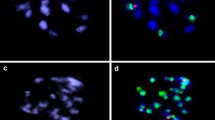Abstract
New types of cytoplasmic male sterility (CMS) in Brassica oleracea would be useful for F1 hybrid seed production. The `Anand' cytoplasm derives from the wild species B. tournefortii. Rapid cycling stocks of B. rapa and B. oleracea were used in cybridization experiments as donor and recipient of `Anand' (=`tour') CMS, respectively. Prior to fusion with PEG, donor protoplasts were inactivated with 30 krad γ-rays and recipient ones with 3 mM iodoacetate, respectively. No calli were obtained from the pre-treated protoplasts. The frequency of shoot regeneration was 21–43% in untreated B. oleracea controls, but only 0–0.5% in `Anand' B. rapa. Putative cybrids were regenerated from about 3% of the calli from fused protoplasts. Regenerated plants were analyzed for nuclear DNA content, plant and flower morphology, pollen production, female fertility, cold tolerance, and organelle composition. Eighty-one percent of the regenerated controls and 63% of fusion-derived plants were diploid. The rest showed DNA contents corresponding to 2x–4x, 4x, or higher ploidy levels, presumably due to somatic doubling in vitro and/or fusions in which the donor nucleus was not completely eliminated. Sixty-four percent of the cybrids had stamens and petals varying in size and shape and were male-sterile, with indehiscent anthers. Their phenotype was otherwise similar to that of B. oleracea. The remaining plants had normal flowers and were male-fertile. Data from crosses with fertile pollinators indicated good female fertility in some of the sterile lines, both after hand and insect pollinations in cages. Mitochondrial (mt) segregation in the cybrids was slightly biased towards `Anand' mitochondria, and the presence of `Anand' mtDNA fragments was strongly associated with male sterility. Evidence of mtDNA rearrangements was obtained in some cybrids. Segregation of chloroplasts was slightly biased towards B. oleracea. The presence of `Anand' chloroplasts with a B. oleracea nucleus did not result in cold temperature chlorosis, as seen in `Ogura' CMS plants.
Similar content being viewed by others
Author information
Authors and Affiliations
Additional information
Received: 22 February 1996 / Accepted: 10 May 1996
Rights and permissions
About this article
Cite this article
Cardi, T., Earle, E. Production of new CMS Brassica oleracea by transfer of `Anand' cytoplasm from B. rapa through protoplast fusion. Theor Appl Genet 94, 204–212 (1997). https://doi.org/10.1007/s001220050401
Issue Date:
DOI: https://doi.org/10.1007/s001220050401




